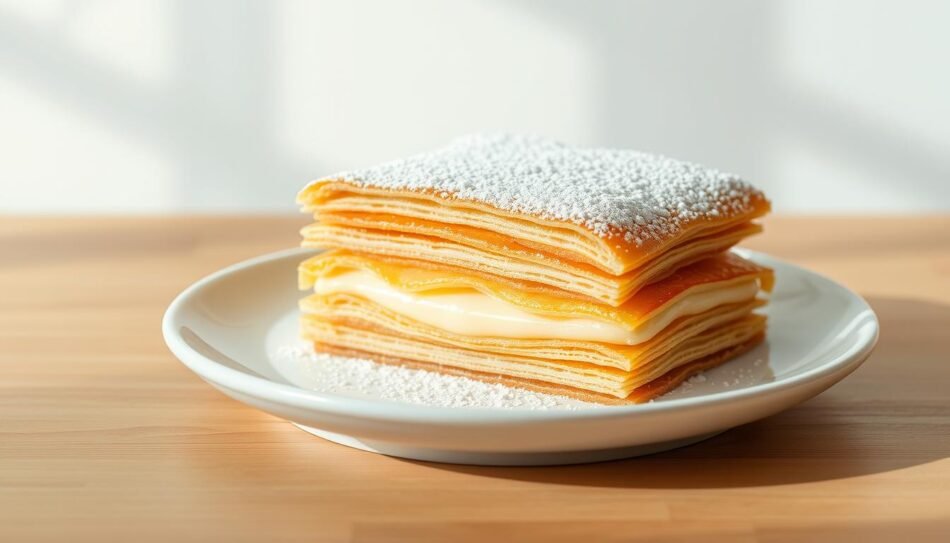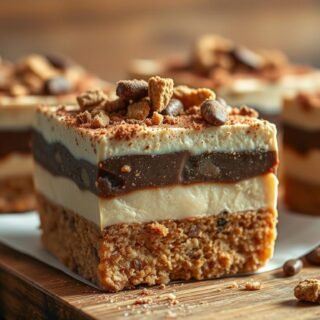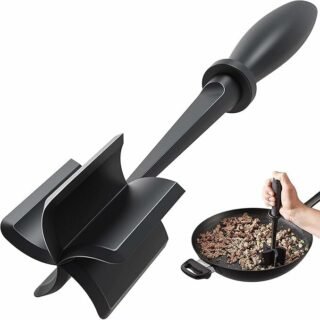Discover how to make the perfect Mille Feuille at home with our step-by-step guide. Learn the secrets of creating flaky layers and silky cream for this elegant French dessert.
Every bite of a mille feuille tells a story of French culinary art. My first time trying it was in a small Parisian bakery. The layers of puff pastry and vanilla cream changed how I saw desserts.
The mille feuille, or « thousand layers » in French, is more than a French custard slice. It shows the beauty and precision of French patisserie. It’s where pastry and cream come together in a dance of flavors and textures.
Each slice is a piece of culinary history, made with techniques passed down through generations. From its delicate layers to its rich past, the mille feuille is a masterpiece of dessert making.
Key Takeaways
- Mille feuille means « thousand layers » in French
- A classic example of French pastry excellence
- Combines crisp pastry with smooth cream filling
- Requires precise technique and skill to create
- Represents centuries of baking tradition
The History and Heritage of Napoleon Pastry
The layered puff pastry, known as mille-feuille, has a rich history. It has been loved for centuries. This Parisian cake is known for its intricate history and evolution in European pastry making.
The story of this dessert is fascinating. It started in 17th-century French cuisine. Bakers then were experimenting with new pastry techniques.
Culinary Roots in French Cuisine
The early days of mille-feuille were special. Bakers focused on:
- Intricate layering techniques
- Precise butter integration
- Delicate texture creation
European Pastry Making Evolution
As mille-feuille spread across Europe, regions made their own changes. Pastry chefs tried new fillings and decorations.
| Region | Unique Contribution |
|---|---|
| France | Original vanilla cream filling |
| Italy | Chocolate and hazelnut variations |
| Austria | Elaborate layering techniques |
Modern Interpretations and Variations
Today, pastry chefs keep making mille-feuille their own. They create both traditional and new versions. This shows the art of French pastry making is still alive.
The mille-feuille’s charm comes from its mix of crispy pastry and smooth cream. It’s a true classic in French pastry.
Understanding the Classic Mille Feuille Structure
A classic mille feuille is a delicate flaky dessert. It shows the art of French pastry making. To get its signature texture and look, it needs precise technique and skill.
The traditional structure of a mille feuille has three key parts. They work together for a perfect culinary experience:
- Crisp puff pastry layers
- Smooth pastry cream filling
- Delicate decorative topping
To make this flaky dessert, bakers focus on thin pastry layers. They create alternating layers of butter and dough through careful folding. This makes the pastry crisp and airy, just right for a layered puff pastry.
| Layer | Composition | Purpose |
|---|---|---|
| Bottom Layer | Baked Puff Pastry | Provides Structural Foundation |
| Middle Layer | Pastry Cream | Adds Creamy Texture |
| Top Layer | Additional Puff Pastry | Creates Visual Appeal |
Mastering the structure needs precision in baking and assembly. Each layer must be carefully made. This ensures the mille feuille stays delicate, with crisp pastry and smooth cream.
Essential Ingredients for Perfect Puff Pastry Layers
Making a flaky dessert in a french bakery needs precision and knowing the right ingredients. Puff pastry is key for many delicate pastries. It requires careful picking of ingredients and techniques.
The secret to a great mille feuille is mastering layering and picking the right ingredients. Your path to making top-notch pastry starts with knowing the basic elements.
Selecting Quality Butter and Flour
When making your flaky dessert, pick ingredients that count:
- European-style butter with higher fat content (82-85%)
- Unbleached all-purpose or pastry flour
- Cold ingredients to keep the structure right
Store-bought vs Homemade Puff Pastry
Your choice depends on your skill and time. Store-bought options are convenient, but homemade puff pastry gives a better texture in a french bakery.
Temperature Control Tips
Keeping the temperature steady is key for crisp layers:
- Keep butter chilled but soft enough to work with
- Let the dough rest between folding
- Work in a cool kitchen
Pro tip: Chill your dough for 30 minutes to stop butter from melting and get perfect layers.
Mastering the Vanilla Pastry Cream Filling
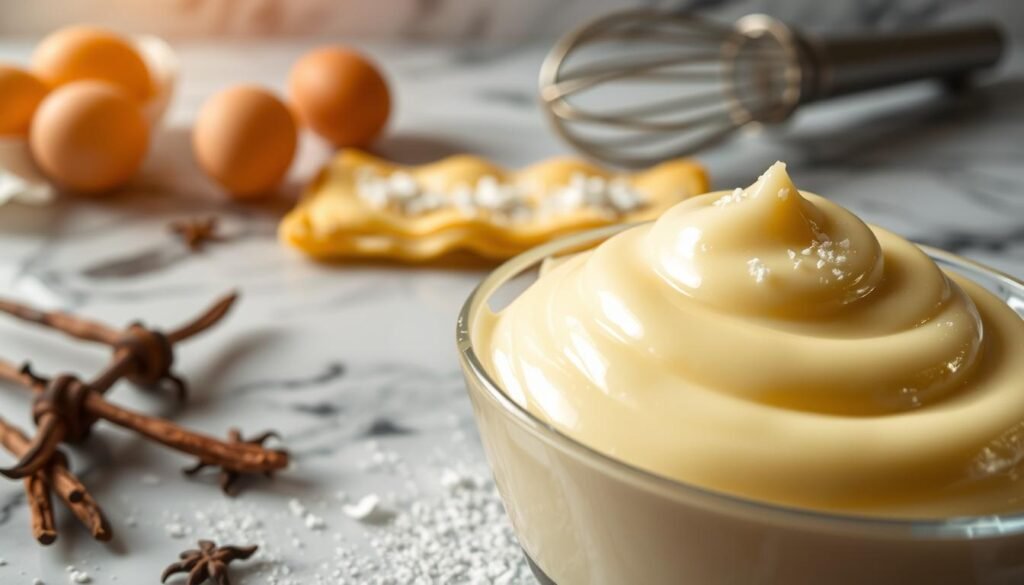
Making the perfect vanilla cream dessert filling is an art. It turns your French custard slice into something truly special. The secret is in the smooth, rich pastry cream that pairs well with the puff pastry layers.
To start your vanilla cream dessert adventure, you’ll need a few important ingredients:
- Whole milk
- Egg yolks
- Granulated sugar
- Cornstarch
- Pure vanilla extract
- Unsalted butter
Making a classic French custard slice filling needs care and patience. Begin by whisking egg yolks with sugar until they’re light and fluffy. Slowly add cornstarch to avoid lumps in your final cream.
When heating the milk, look for small changes. Aim for a custard that’s thick but still spreads well between pastry layers. Pastry experts say to cook it until it’s like pudding.
Pro tip: Always strain your vanilla pastry cream through a fine-mesh sieve to ensure ultimate smoothness.
If you’re feeling adventurous, try adding flavors like lavender or a bit of rum. The goal is to keep the creamy texture that makes a French custard slice unforgettable.
Step-by-Step Assembly Techniques
Making a perfect layered puff pastry dessert needs precision and careful technique. Assembling a mille feuille might seem hard, but with the right steps, you’ll make a stunning custard pastry. It will impress everyone at the table.
Start by preparing your parts well. Your layered puff pastry and custard pastry should be at the right temperature. This ensures the best results.
Layering Methods for Stability
To make a stable mille feuille, layer carefully:
- Begin with a completely cooled puff pastry sheet
- Make sure pastry sheets are crisp and flat
- Trim edges with a sharp knife for even layers
- Apply gentle, consistent pressure when stacking
Proper Filling Distribution
The key to a great custard pastry is even filling. Spread your pastry cream carefully:
- Use an offset spatula for smooth application
- Make a thin, uniform layer of cream
- Avoid overfilling to prevent collapse
- Leave a small border around edges to prevent overflow
Achieving Clean Cuts
Slicing your layered puff pastry needs precision. Use a sharp, serrated knife and clean it between cuts for crisp edges. Chill the assembled pastry for 30 minutes before cutting to ensure clean, beautiful slices.
Pro tip: A hot, clean knife will help you achieve picture-perfect mille feuille every time.
Traditional vs Contemporary Decorating Styles
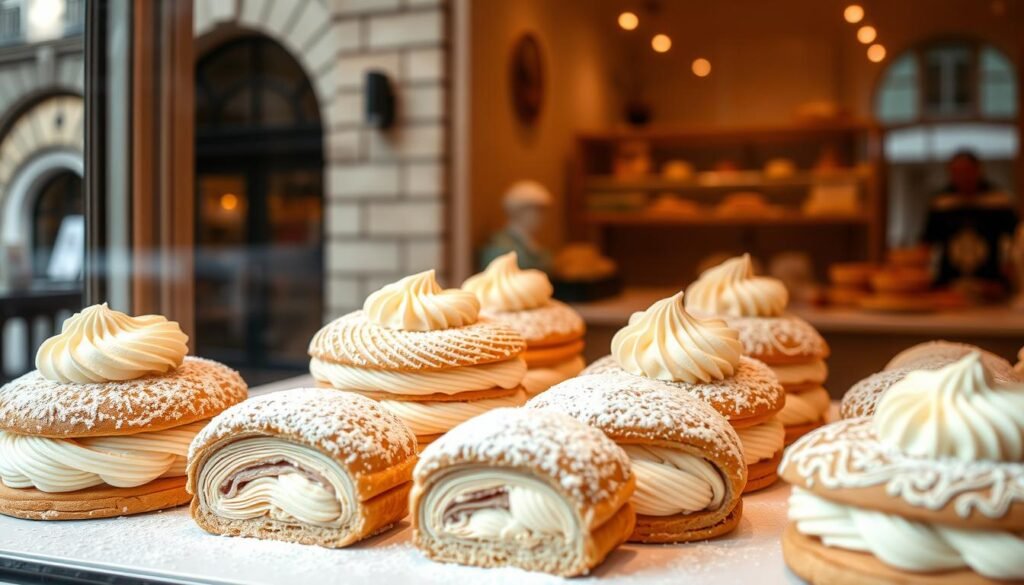
Decorating a classic parisian cake like mille feuille offers a wide range of styles. The traditional French bakery style is all about elegance and simplicity. It showcases the pastry’s layers and flavor beautifully.
Traditional decoration methods for mille feuille include:
- Marbled icing with chocolate and vanilla swirls
- Delicate powdered sugar dusting
- Simple glaze covering the top layer
Modern decorators are now exploring new ways to decorate this classic dessert. They use vibrant colors, artistic chocolate drizzles, and edible flowers. They also add textures like caramel shards.
- Vibrant colored icings
- Artistic chocolate drizzles
- Edible flower garnishes
- Textural elements like caramel shards
| Style | Key Characteristics | Visual Appeal |
|---|---|---|
| Traditional | Subtle, classic patterns | Elegant and refined |
| Contemporary | Bold colors, experimental designs | Artistic and adventurous |
Your choice of decoration can turn the mille feuille into a masterpiece. Try out different techniques to show your style while honoring the French bakery tradition.
Common Mistakes to Avoid When Making Mille Feuille
Making the perfect napoleon pastry needs skill and precision. This flaky dessert may look elegant, but several common mistakes can ruin your baking. Knowing these pitfalls will help you make a stunning mille feuille that wows everyone.
Temperature Control Challenges
Getting the right temperature is key when making your napoleon pastry. If the butter is too warm or the oven temperature is off, it can mess up the layers of your flaky dessert.
- Keep butter chilled until just before use
- Preheat the oven to exact specifications
- Use a reliable kitchen thermometer
Assembly Complexity
The way you layer your mille feuille is crucial for its structure. If you rush the assembly, your pastry might collapse or not be even.
| Common Assembly Issue | Prevention Strategy |
|---|---|
| Uneven Pastry Layers | Roll dough carefully, use consistent pressure |
| Cream Seepage | Allow layers to cool completely before filling |
| Structural Weakness | Chill between layering steps |
Storage Considerations
Storing your napoleon pastry right is important. Cream-based desserts need careful handling to stay fresh and avoid bacterial growth.
- Refrigerate immediately after preparation
- Consume within 24-48 hours
- Cover loosely to prevent moisture buildup
Pro tip: Always serve your mille feuille chilled for the best texture and flavor experience.
Storage Tips and Shelf Life
Keeping a custard pastry fresh is crucial. Your French custard slice is a delicate treat. It needs special care to stay perfect.
Refrigeration is essential for storing your mille feuille. The creamy filling and thin pastry layers must stay cool. This prevents them from losing their texture and flavor.
- Refrigerate within 2 hours of making
- Store in a sealed container
- Keep at 40°F (4°C) or colder
- Eat within 1-2 days for the best taste
Leaving your French custard slice out too long can ruin it. The powdered sugar gets soggy, and the pastry becomes soft and less tasty.
Pro tip: Use parchment paper between each layer. This stops them from sticking together and keeps each pastry layer fresh.
Remember: Fresh is always best when it comes to delicate pastries like mille feuille!
To enjoy your custard pastry fully, eat it chilled and right after making it. Proper storage lets you enjoy every creamy, delicate bite of this classic French dessert.
Serving Suggestions and Presentation Ideas
Presenting a mille feuille from a french bakery is an art. Your vanilla cream dessert needs a stunning showcase. This highlights its delicate layers and texture. The right presentation can turn this classic pastry into a masterpiece.
When serving mille feuille, consider these elegant presentation techniques:
- Use a pristine white plate to create visual contrast
- Dust with powdered sugar for an elegant finishing touch
- Garnish with fresh berries or mint leaves
- Serve at slightly cool room temperature for optimal flavor
Eating this delicate pastry requires a specific approach. Gently slice through the layers using a sharp knife and fork. This ensures you capture all components in each bite. Your guests will appreciate the careful technique that preserves the pastry’s intricate structure.
For special occasions, consider individual plating techniques. These showcase the vanilla cream dessert’s architectural beauty. A simple rectangular plate with a carefully placed mille feuille can create a stunning visual centerpiece.
Pro tip: Pair your mille feuille with a light champagne or sweet dessert wine to elevate the tasting experience.
Experiment with different garnishes and presentation styles. This makes your french bakery-inspired dessert truly memorable. The key is to balance visual appeal with the pastry’s delicate nature.
Nutritional Information and Dietary Considerations
Enjoying a napoleon pastry is a treat. Knowing its nutritional facts helps you make better choices. This classic Parisian cake is a delightful indulgence with some dietary points to consider.
A typical napoleon pastry has a lot of calories. An average slice has about:
- 300-350 calories
- 18-22 grams of fat
- 25-30 grams of sugar
For those with dietary needs, there are ways to enjoy this pastry:
- Gluten-free options: Use almond flour or gluten-free puff pastry
- Lower-sugar alternatives: Replace traditional sugar with stevia or monk fruit sweetener
- Dairy-free modifications: Substitute milk-based cream with coconut or almond cream
Controlling portion size is important when eating napoleon pastry. A small slice can satisfy your sweet tooth without overloading on calories. Try sharing with a friend or saving half for later to keep calorie intake in check.
While the Parisian cake is a rich treat, it’s important to enjoy it in moderation. Treat yourself to napoleon pastry as an occasional delight, part of a balanced diet.
Conclusion
Exploring mille feuille shows us more than just a tasty French dessert. It’s a journey that mixes precision, tradition, and creativity. Making this pastry at home shows us how skilled we can become.
The mille feuille is a symbol of French pastry art. Its layers of puff pastry and cream show the skill needed in baking. Whether you’re new or experienced, trying this dessert can change how you see baking.
Learning to make mille feuille takes time and effort. Each try gets you closer to a dessert that’s both delicious and connected to a long tradition. Remember, getting better takes time, and every mistake is a step towards mastering French baking.
In the end, mille feuille is more than a dessert—it’s an adventure. It pushes you to try new things, value detailed techniques, and share a bit of French tradition with others. Enjoy the process, relish each bite, and keep exploring the world of pastry.

